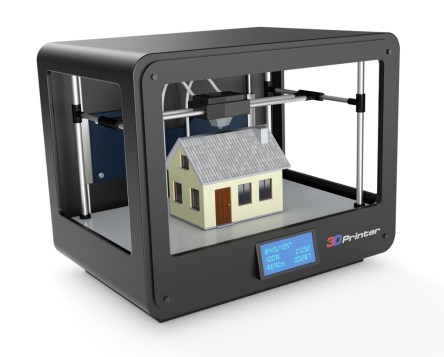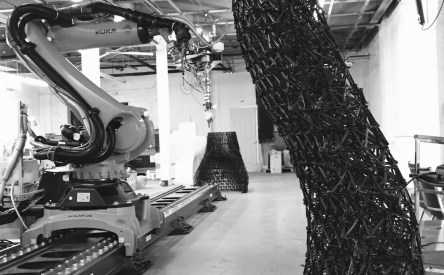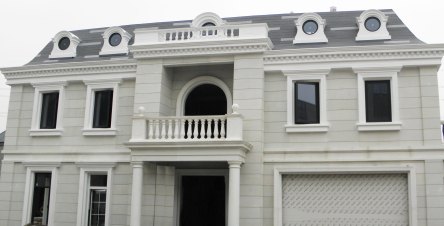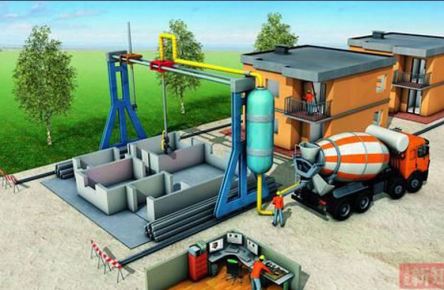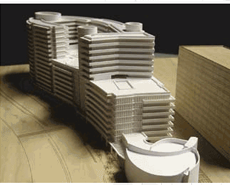3D printing has picked up the pace in the housing market, especially with inflation rising. Builders can print houses faster building with more earth friendly resources and fewer staff. Let’s explore the latest updates with 3D homes in the affordable and single-family housing markets. The University of Maine unveiled the first 100% bio-based 3D printed home made entirely with bio-based materials. It features 3D-printed floors, walls, and roofs of wood fibers and bio-resins. The house is fully recyclable and highly insulated with 100% wood insulation and customizable R-values. “Our state is facing the perfect storm of a housing crisis and labor shortage, but the University of Maine is stepping up once again to show that we can address these serious challenges with trademark Maine ingenuity,” said Gov. Janet Mills. “With its innovative BioHome3D, UMaine’s Advanced Structures and Composites Center is thinking creatively about how we can tackle our housing shortage, strengthen our forest products industry, and deliver people a safe place to live so they can contribute to our economy. While there is still more to be done, today’s development is a positive step forward — one that I was proud to support through my Maine Jobs & Recovery Plan and my budget.” The technology is designed to address labor shortages and supply chain issues that are driving high costs and constricting the supply of affordable housing. Due to automated manufacturing and off-site production, less time is required for on-site building and fitting up the home. Printing using abundant, renewable, locally sourced wood fiber feedstock reduces dependence on a constrained supply chain. These materials support the revitalization of local forest product industries and are more resilient to global supply chain disruptions and labor shortages. Using advanced manufacturing processes and materials, future low-income homes can be...
ICON
Tiny Homes with Heart
Tiny house manufacturers have long posited themselves as serious competition for the multifamily housing industry. Yet for years, there have not been any real contenders. ICON is positioned to change the real estate landscape. 3D Printing Reimagined ICON revealed a 3D-printed tiny home that is functional, beautiful, and affordable. The floor plans range from 650-800 square feet. Even the smallest floor plan is equipped with a bedroom, bathroom, and living room. Residents can enjoy additional living space thanks to a spacious wrap around porch. Building—or printing—these concrete homes takes as little as 12 hours. The larger homes take 24 hours, which still clocks-in months in advance of traditional housing structures. More than 100 one-inch thick layers of concrete create the durable walls of the abode. How much will these homes set you back? Currently only $10,000 USD. ICON has a Tesla-styled plan, however, to lower the cost over time to just $4,000. Both prices are significantly less than the cost of most double-wide mobile homes. The price tags is also significantly lower than the cost of renting in most major cities—if you have the land, of course. I Each structure is net zero energy, thermally efficient, and fully permitted for construction throughout the United States. Housing with Heart At the heart of these tiny houses rests a desire to see everyone in a safe, comfortable home that they can afford. ICON has initiated international housing projects that are just as altruistic as they are practical. The organization partnered with New Story to change the lives of 100 families in El Salvador. The duo recognizes that home is the foundation needed for families to thrive. Protection from the elements and decreased exposure to soil- and water-borne parasites are just a few ills families can avoid...
Printing a Building
Branch Technology
The 3D printing technology continues its adventure, conquering industry after industry. Among the latest highly debated upon is the construction industry and the upgrades 3D printing brings to it. It’s no surprise as construction is a $1 trillion industry in the United States ($8.5 trillion worldwide) and accounts for 8-10% of the U.S. GDP. Startup Branch Technology of Chattanooga, Tennessee, led by visionary Platt Boyd, came up with a new approach inspired by nature. The company announced at GIGTANK, a boutique accelerator for startups developing high-bandwidth business applications, that it is the first company to successfully construct building walls at scale using the world’s largest freeform 3D printer; they are the winners of the Investor’s Choice Award. Branch’s mission is to simplify the work of architects by giving them more freedom to incorporate new geometries into their designs, inspired by nature. Like bones in our body or trees in the forest, optimized geometries are made strong and functional by the material filing the matrix. After that, the interior and exterior skins can be finished in any way. To achieve that, Cellular Fabrication™ (C-Fab™) was designed as Branch’s patented freeform 3D printing process. It turns the question “how much can we build?” into “how little can we build?” Freeform printing in open space is freed of the slow, layer-by-layer build process of traditional 3D printing. They’ve came up with an algorithm which creates both the geometry and robotic motion to construct complex geometries in open space, saving on the use of support materials and on highly controlled build environments. The technology uses a 12-and-a-half-foot Kuka robotic arm which travels on a 33-foot rail to build a simple lightweight scaffolding made out of ABS plastic reinforced with carbon fiber. Then, using the same tools that contractors...
3D Printed Apartments...
A reality in China
Gutenberg invented the printing press in 1439; since then the printing industry has evolved, from printing blocks to 2D printers with the capacity of mass-producing documents in just minutes. Today, 3D printers are capable of creating pretty much anything, from mechanical parts to prosthetics to buildings. Even though it’s been 32 years since an engineer named Chuck Hull invented 3D printing, only recently the process became one of the industries of the moment for investors. From 2011 to the present day 3D printing has raised almost $4 billion, while during 1987-2010 (23 years) it raised only $300 million. Increase in interest by public investors translates into extraordinary potential and profit in the industry. 3D printing advocates say the technology will be routinely used to build homes, food, and human tissue and believe that it has the potential to revolutionize how we do everything. A good example is General Electric, which announced that it is using this technology to make the next generation LEAP airline engine that will save fuel consumption and expense. Probably the even better news is that 3D printing is no longer reserved for corporations only, but available to all. A Chinese construction firm, WinSun Decoration Design Engineering, unveiled a five-story apartment building, dubbed “the world’s tallest 3D-printed building,” along with a 11,840-square-foot neoclassical mansion, both made entirely with a giant 3D printer. The properties were built with a patented ink created from a combination of recycled construction waste. This project follows last year’s revolutionary initiative when the company built 10 affordable houses in 24 hours, each of 650 square feet at around $4,800. For the affordable project the company used four 3D printers that measure 20 feet in height, 33 feet in width, and 132 feet in length. The process is...
A House in 24 Hours
A robot built it
Giant 3D printers, though still in the research stage, may be the perfect candidate to replace built-by-hand homes. USC Professor Behrokh Khoshnevis designed a robot able to build a 2,500-square-foot home in just 24 hours. The process, called Contour Crafting, is in fact scaling up 3D printing to the scale of the building. The big robot’s actions are dictated by a computer program: the construction site is cleared and leveled; the workers lay down two rails a few feet further apart than the building’s width and a computer-controlled contour crafter takes over from there. A gantry-type crane with a hanging nozzle squirts out concrete and with a components-placing arm travels along the rails. The nozzle lays layers of concrete creating hollow walls, and fills them in with additional concrete. People would only install doors and windows. The animation here gives a pretty good idea of how it would ultimately work. “It’s a CAD/CAM solution,” says Khoshnevis. The buildings are “designed on computer and built by a computer”. This method has proved to produce much stronger structures than traditional building methods. According to Contour Crafting, the tested wall is a 10,000PSI (pounds per square inch) strength compared to the average 3,000PSI of a regular wall. With the Contour Crafting solution the cost of home-owning could be slashed, making it possible for millions more humans – especially in developing countries – to have houses. The first thing that comes to mind is the opportunity to build emergency and replacement housing in disaster relief areas, such as recovery from typhoons and hurricanes. It could also be used to build high-quality shelter for those living in desperate conditions: at the beginning of the 21st century, there are almost one billion people in need of stable housing around the world....
3D Printing
A world-changer?
3D printing (also known as additive manufacturing and stereo lithography) utilizes an extruder to construct objects a single layer at a time, in varying micron thicknesses, according to the specifications of a CAD program. These printers can use a wide range of materials, from various plastics and PVC, to aluminum and titanium. Watch as a rack of fold-up multi-tools is ‘grown’ in just a few hours: The advantages of 3D printing, over traditional manufacturing, are that it is better, faster and cheaper than its predecessor. The technology is in its fourth decade and applications already run the gamut. 3D printing is used for military, medical, engineering tasks of every stripe, and has also been employed to make jewelry and footwear. It has great potential as a future method for creating artificial limbs for amputees. Within the real estate world, architects and developers are familiar with the technology as it is used for 3D rendering of scale building project models that can be presented to investors, owners, approval bodies and financiers. CAD and concept modeling applications are one of the best established consumer uses of 3D printers. So why does this technology still seem to be flying under the radar? Blame popular media coverage, which overwhelmingly focuses on the novelty aspects of the technology (“You can use it to build Legos!”), while simultaneously posturing that widespread access to such devices exists only in the far future. There seems to be an unwritten law that if you write about 3D printing you must, in the title, reference the fact that it will either shape the future or change the world. Heavy hitters like Forbes, CNET, and Technology Review have bought in. There’s even unrealistic concern that consumers with access to 3D printers could “pirate” popular toys...

